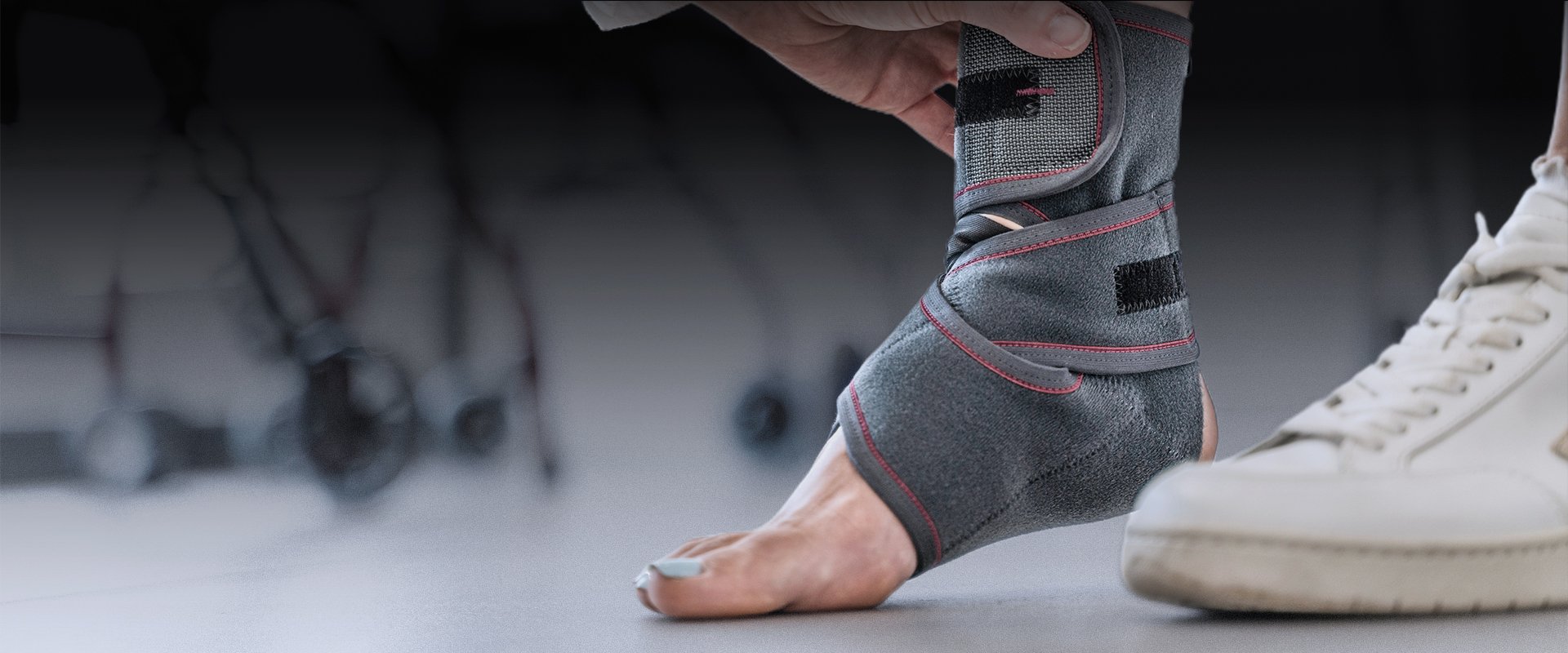
Physical Therapy for ankle Rehab
AT EVOLVE
Physical Therapy for ankle REHAB
WHY CHOOSE PHYSICAL THERAPY FOR ANKLE REHABILITATION?
Physical therapists are movement experts trained in the rehabilitation of injuries and surgeries to the ankle. They address pain, impairments, activity limitations and participation restrictions with the goal of improving an individual's function. Physical therapy is not a quick fix but is aimed at addressing underlying causes of your symptoms and promoting long-lasting solutions.
Your physical therapist will assess your ankle and nearby areas, interview you about your ankle symptoms and learn about the activities that are limited by these symptoms. This allows your therapist to create a comprehensive rehabilitation program that addresses underlying causes of pain and injury, restores tissue health and function and prepares your ankle for return to normal activities.
Ankle injuries commonly treated by physical therapists include:
Posterior ankle impingement
Achilles tendon injuries or tendinopathies
Ankle sprain
Peroneal tendon injury
Sinus tarsi syndrome
Medial ankle stress fracture
Tibialis posterior tendonitis
Tarsal Tunnel Syndrome
Anterior ankle impingement
High ankle sprain
Arthritis
Ankle surgeries commonly rehabilitated by physical therapists include:
Ankle fusion
Ankle replacement
Lateral ankle ligament reconstruction
Ankle tendon repair
Fracture repair
Ankle nerve decompression
WHAT DOES ANKLE REHABILITATION LOOK LIKE?
Physical therapy for an ankle injury, a chronic ankle issue or following ankle surgery is aimed at ameliorating symptoms of pain, instability or stiffness, helping restore normal strength and range of motion and facilitating return to full activities.
My team of therapists and I will start by getting to know your concerns and goals and performing a thorough physical exam to determine what areas we should target with our physical therapy interventions. Your therapist will employ manual therapy interventions to target joint and tissue mobility while also prescribing movements and exercises for strength, motor control and mobility to be performed in the home and the clinic.
Following ankle surgery, your surgeon may provide a post surgical rehabilitation protocol that will guide your physical therapy program to promote healing while protecting the surgical site.
HOW LONG DOES ANKLE REHABILITATION TAKE?
The duration of your physical therapy rehab plan of care will vary depending on the severity of symptoms, if you are recovering from or planning to undergo surgery, as well as the types of activities you aim to resume. While full resolution of symptoms can take some time, you may begin to see some results right away. You should experience improvements in many symptoms such as pain, stiffness, and inflammation within a couple of weeks but returns in strength, flexibility and overall mobility may take longer. Achieving long lasting results may take some time, but dedication to your program will not only help you achieve these results but help to decrease the likelihood of symptoms recurring in the future.
UNDERSTANDING THE ANKLE
The ankle is a hinge joint where the primary motion is to lift and point the foot. If you look at an image of the ankle joint you will see the larger inner bone of the lower leg leg called the tibia and the thinner outer bone called the fibula articulate with a bone called the talus in the posterior part of the foot. Beneath the talus lies the calcaneus or heel bone. Many ligaments, muscles. and tendons travel between the bones of the lower leg and foot, crossing the ankle joint. The primary motion of the ankle joint is dorsiflexion and plantarflexion or lifting and pointing the foot. The motion that occurs at the joint between the talus and calcaneus bones allows the foot to turn in and out and any of these motions can be affected with an ankle injury.
Because of the complex anatomy in the ankle area, there are many potential sources of ankle pain or discomfort. The bones can experience a fracture, the joints may be affected by conditions like osteoarthritis, ankle sprains can affect the ligaments and strains and tendinopathies can affect the muscles and tendons of the ankle. Some injuries can be pinpointed through careful clinical testing such as palpating for painful tissues or testing the muscles, but in some cases imaging such as an x-ray, CT scan, ultrasound or MRI may be recommended to better visualize the tissues.
WHAT SYMPTOMS DOES ANKLE REHABILITATION TARGET?
In addition to pain, ankle rehabilitation targets impairments, activity limitations and participation restrictions related to your ankle symptoms. To get a better understanding of what symptoms ankle rehabilitation targets, continue reading
Body structure and function impairments:
- Weakness in the muscles around the ankle
- Difficulty moving the ankle in one or more directions
- Swelling around the ankle joint
- Feelings of instability in the joint
- Loss of flexibility or range of motion in the ankle
- Changes in joint mobility
- Numbness or tingling in the ankle or foot
- Difficulty walking
- Difficulty standing
- Inability to run, hike, jump, cut, skate, ski and more
- Difficulty climbing stairs
- Reduced ability to perform your work duties due to ankle symptoms
- Inability to participate fully in athletics
- Interrupted sleep due to pain or discomfort
End Injury Progression
Physical therapy for ankle rehab has proven to prevent injury, slow and even stop pain issues, improve performance, and reverse injury progression in many cases.
Relieve Pain
The movements used in this technique can target your entire body helping you to manage discomfort and pain during the course of your physical therapy treatments.
Improve Range of Motion
Posture awareness is an important area to focus on due to the fact that certain positions may cause you further discomfort and pain.
Restore Mobility
You can regain mobility and flexibility by taking part in the stretches and exercises as prescribed by your physical therapist.
How Long Will Physical Therapy for ankle Rehab Last?
COMMON ANKLE REHABILITATION TREATMENTS USED BY PHYSICAL THERAPISTS
Your physical therapist will design an individualized treatment plan just for you, however, these are some of the more common rehabilitation interventions for the ankle that you might experience when working with your PT:
Modalities and manual therapy techniques to the ankle and surrounding areas reduce pain and inflammation and promote tissue healing
Weight bearing modification recommendations such as the use of bracing, taping or an assistive device like a cane or walker to offload tissues in the earlier stages of healing
Education about your injury, the stages of healing and what you can do to participate in your recovery and prevent future injury
Muscle strength, endurance, motor control and power training to improve stability, endurance, coordination and strength for return to normal activity
Tissue and joint mobilization, mobility and stretching techniques to restore normal range of motion and flexibility
Gait training to restore normal walking mechanics with walking and running
Sport and work specific training exercises to prepare the ankle to return to your prior activities and limit the risk of future injury.
As you can see, physical therapists have a lot of treatments in their toolbox to rehabilitate the ankle. If you have an injured ankle, are undergoing ankle surgery or are noticing uncomfortable symptoms in your ankle, call us today to learn more about our services and schedule an evaluation
Mill Basin (located in Harbor Fitness)
6161 Strickland Ave
Brooklyn, NY 11234
Monday: 7am-8pm
Tuesday: 7am-8pm
Wednesday: 8am-5pm
Thursday: 7am-8pm
Friday: 8am-1pm
Park Slope (located in Harbor Fitness)
550 5th Ave.
Brooklyn, NY 11215
Monday: 9am-8pm
Tuesday: 8am-6pm
Wednesday: 9am-8pm
Thursday: 8am-6pm
Friday: 8am-3pm
Gravesend
372 Avenue U
Brooklyn, NY 11223
Monday-Thursday: 8am-8pm
Friday: 8am-3pm
Kings Highway
945 Kings Highway
Brooklyn, NY 11223
Monday-Wed.: 12pm-8pm
Ready to take the next step to a healthier you?
Contact Us Today!
Physical Therapy for Ankle Rehab!
Need Ankle Rehab?
Let our caring and compassionate physical therapists help you with relieving pain while getting you back on your feet comfortably.
Call now to schedule your first PT consultation free of charge.
Call: 1-718-258-3300







